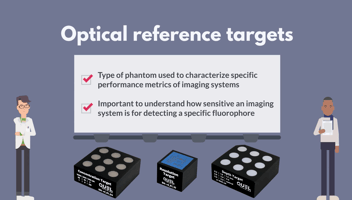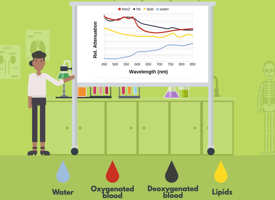A Look at Optical Reference Targets For developers and users of fluorescence imaging systems,...
Performance Evaluation for FGS Systems: Phantoms
Two key components of TG311 focus on developing recommendations for measuring clinically-relevant performance of FGS systems, and additionally, defining the tools or aids necessary to complete evaluations. Phantoms are a common tool used during the development of medical imaging systems, and are used to mimic the imaging environment for the intended use. As described in the preprint, there are specific qualities needed in phantoms:
- Simulate relevant optical properties,
- Provide the ability to collect metrics specific to particular use-cases,
- Reliably manufacturable, and
- Stable for a known and usable time period
The paper goes on to describe the four components common to most phantoms used in FGS:
- A base matrix material (i.e. liquid, gel, solid),
- Scatterer,
- Absorber, and
- Fluorophore
There are a number of different methods to combine these four components to address the four qualities needed for system characterization. Various “recipes” have been proposed in literature over the past two decades. An earlier paper by Pogue et al reviews a number of common additives used in liquid phantoms, as well as a few other base materials. One of the key findings of this earlier work was the need to standardize, due to large discrepancies between groups and instrumentation with only “10 to 15% agreement between groups,[and] some measurements having close to 50% disagreement.” This earlier work also primarily focused on developing phantoms for optical spectroscopy applications, and not fluorescence.
A decade later, the Ntziachristos group published on the development of a solid composite phantom utilizing quantum dots as a stable fluorophore, for the purpose of fluorescence imaging system characterization. This design moved away from liquid and gelatin phantoms which can be easier to create, but lack long-term stability. The proposed reference phantom used metal-based scatterers and absorbers that mimic the optical properties of blood. Quantum dots were chosen due to long-term stability, in contrast to many of the clinically used organic fluorophores which experience photobleaching with use. Micro-milling techniques were also developed to implement multi-layer structures, required for more comprehensive system characterizations.
The Pogue and Ntziachristos groups then collaborated to develop a similar solid phantom which utilized an ICG-equivalent fluorophore. This design also used 3D-printed molds and a based material consisting of a two-part epoxy mixed with scattering and absorbing additives. Through further development within the Pogue group, this design was followed by a fully 3D-printed design which greatly improved manufacturability. Due to the flexibility of 3D-printing, this manufacturing method provides the ability to demonstrate anthropomorphic phantoms, which are outside the scope of the TG311 aims, but provide interesting potentials for visualization demonstrations and training purposes.
While solid phantoms improve usability and repeatability, their commercial availability is currently limited to specific fluorophores. When testing novel contrast agents, liquid serial dilutions are still used. The liquid solutions can follow many of the same recipes discussed previously and imaged in multi-well plates, or commercially available calibration devices. To address the need for incorporating reliable optical properties and biomimetic environments, 3D-printed solutions have also been demonstrated.
There are a lot of choices when it comes to developing phantoms suitable for specific use cases. How to use each phantom or reference target will be discussed in future posts. At QUEL Imaging we spend a lot of time thinking about these challenges, so you don’t have to. Please reach out to us if you want to discuss your project needs.



